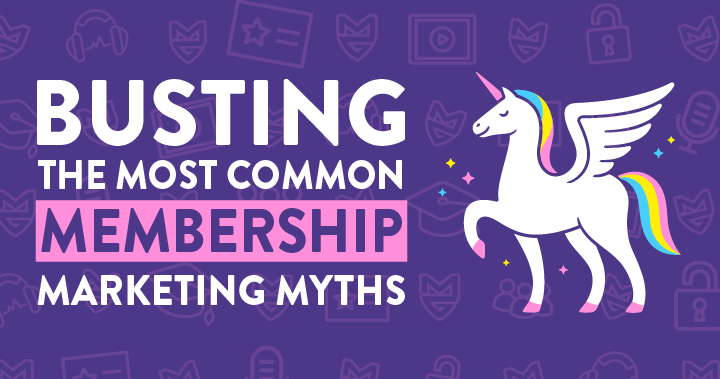When it comes to membership marketing, can you tell the difference between good advice and bad?
There’s a lot of info out there about marketing your membership, but in the world of online business, unfortunately a lot of it is unhelpful noise at best, and at worst, could be damaging to your reputation.
Many of us have learnt the hard way to stay away from marketers who try and sell you their secret shortcut or silver bullet, however, some of these myths are so common, they’re almost believed to be the industry standard of membership marketing.
So, how do we avoid the nonsense?
Here are the six most common membership marketing myths, and how you can avoid them:
Myth #1: You need to make people buy today or not at all
The most common myth (and arguably most infuriating) is that you need to give people a reason to buy your product today.
It’s well-known that leads need between seven to nine interactions with a brand before they’re ready to buy.
It’s a long-term, two-way process where people are learning to trust your brand and build a relationship with you.
If you nurture your pipeline correctly during this gestation period, you’re likely to be top of mind when they’re ready to buy.
This process could take weeks, months, or years, but by not pressuring your buyers, you’re ensuring a more positive buyer experience, and they’ll be more inclined to buy from you again in the future.
Trying to shortcut the process and force purchases when you’re ready, rather than the buyer, is going to damage your credibility and make you seem untrustworthy.
Buyers expect their needs to be met by sellers, not the other way around.
Ultimately, pressurizing your pipeline is a lazy marketing tactic.

Forcing a quick sale shows that you’re not thinking long-term and aren’t willing to support your opportunities through a more meaningful buyer journey.
Myth #2: You NEED scarcity to sell
Scarcity is a powerful marketing tactic, but its overuse makes it another piece of bad marketing advice.
There is a time and a place for scarcity marketing.
If you have a venue with limited seat numbers for example, then it makes sense to let people know if there are only a few tickets left.
But for memberships and online products, using urgency and scarcity marketing can feel disingenuous and restrictive.
A common use of scarcity when it comes to membership marketing involved having a “closed door” model – where you only allow people to join during short enrolment windows at specific times of the year.
And the rest of the time, your doors are closed. People can't join.
While there are some situations where the closed door model can make sense – if you're doing it purely because you mistakenly believe that you need to use scarcity to entice people to join, then you could be doing more harm than good!
You're likely missing out on hundreds or even thousands of people who are ready to buy during those periods where your doors are closed.
Those people aren't going to wait until it's convenient for you.
They're going to take their business elsewhere.
Sure, you can try to get them to sign up to a waiting list to be notified when you re-open, but you're gambling that their readiness to buy can easily be deferred until later.
Myth #3: All you need is a great product
While having a great product is the perfect first step to achieving sales, if nobody knows about it, nobody is going to buy it.
The notion that a “good product sells itself” is not a marketing strategy.
Think about it, you could have the best solution to the worst problem in the world but if you’re not marketing it, will anyone know?
While it’s not crucial that you have thousands of social media followers or an exploding email database, you need to have at least a small following to get your product in front of.
By investing time in building an audience you’ll find that you can market to your audience before you launch your product, validate that they want to spend their money on your product, and use any feedback to help shape your marketing strategy and future products.
It’s a relationship that pays dividends – literally.
Once you’ve started to grow a loyal following, then you need to compel them to buy your product.
Myth #4: Focus on quantity over quality
I’ve spoken before about Kevin Kelly’s idea of 1,000 true fans and I’m a big believer in it:
Would you rather have a million social media followers who rarely engage with you or 1,000 followers who buy every product you launch?
I know which I’d prefer.
If you charge each true fan $50 for your monthly membership, that equates to $50,000 of sales per month or $600,000 per year!
So why wait until you have a million followers?
Firstly, you may never get to that amount, and secondly, you can always continue to grow your audience.
The longer you wait, the more sales opportunities you may miss.
Your email subscriber list is a rough benchmark for how many true fans you have.
These are people who’ve actively told you that they’re interested in you and want to hear more from you.
Build momentum by starting to sell to your true fans and keep growing from there through your membership marketing.
Myth #5: This membership marketing strategy is dead!
How many times have you seen this headline, “[insert marketing strategy] is dead”?
SEO is DEAD!
Facebook advertising is DEAD!
Podcasting is DEAD!
It’s an unoriginal tactic often used to promote a replacement strategy and subsequently sell a bogus course or product.
Would you believe that I’ve seen articles claiming memberships are dead… that then go on to promote a course on building your own membership!
One strategy doesn’t have to be “dead” in order to make space for another.
In fact, they all co-exist and can work together as part of a wider marketing strategy.
Once upon a time, it may have been a decent clickbait headline, but now it’s another lazy, clichéd marketing myth.
Myth #6: There's a secret silver bullet in membership marketing
It’s an appealing idea that there is one trick, one secret, one silver bullet for success.
But the truth is, there isn’t.
Successful marketing is a combination of different tactics and a long-term strategy.
No particular tactic is better than another.
No one thing is going to be the solution or the secret sauce.
When shortcuts like this are being pushed, you can guarantee that you’re trying to be sold something… Something that most likely won’t give you the return on investment it promises.
Unfortunately, if it sounds too good to be true, it probably is.






